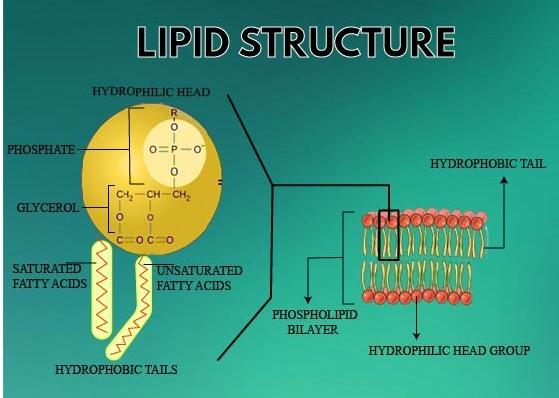
What are the functions of lipids?
Answer
514.2k+ views
Hint: A lipid molecule is a type of fat molecule that constitutes the half part of the human cells. They are insoluble in water and are very important while performing various functions in the body and also produce energy.
Complete answer:
Lipids are fat molecules that are insoluble in water but soluble in organic solvents like alcohol. They are the source of energy for the whole world and are found deep inside the ground. They naturally occur in the form of oil and help in the building of the cell membrane. They are made up of different elements that include carbon, hydrogen, and oxygen and may also contain nitrogen, and phosphorus.
The functions of the lipids are as follows:
1) They are the main component and help in the manufacturing of the cell membrane that helps the cell to maintain its shape and rigidity and also to protect the cell from the outer environment.
2) The lipids act as the storehouse of energy in the case of the plants and the animals.
3)The lipids are in the form of wax which is the outer coating of various stems, leaves, fruits, birds feathers, etc, and are water repellent thus saving them from exposure to excessive water and making them waterproof.
4) The bile acids are the steroids that help in the digestion of fats inside the stomach.
5) They help in regulating the temperature of the body.
6) The fats act as the chemical messenger and release the hormone prostaglandins.

Note:
In the early 1800s, around 1786-1889 the lipids were first discovered by Michel Chevreul, who was a young scientist from France. The lipoproteins are made up of lipids and proteins when they are combined together, they were discovered in 1963 by Kare Berg.
Complete answer:
Lipids are fat molecules that are insoluble in water but soluble in organic solvents like alcohol. They are the source of energy for the whole world and are found deep inside the ground. They naturally occur in the form of oil and help in the building of the cell membrane. They are made up of different elements that include carbon, hydrogen, and oxygen and may also contain nitrogen, and phosphorus.
The functions of the lipids are as follows:
1) They are the main component and help in the manufacturing of the cell membrane that helps the cell to maintain its shape and rigidity and also to protect the cell from the outer environment.
2) The lipids act as the storehouse of energy in the case of the plants and the animals.
3)The lipids are in the form of wax which is the outer coating of various stems, leaves, fruits, birds feathers, etc, and are water repellent thus saving them from exposure to excessive water and making them waterproof.
4) The bile acids are the steroids that help in the digestion of fats inside the stomach.
5) They help in regulating the temperature of the body.
6) The fats act as the chemical messenger and release the hormone prostaglandins.

Note:
In the early 1800s, around 1786-1889 the lipids were first discovered by Michel Chevreul, who was a young scientist from France. The lipoproteins are made up of lipids and proteins when they are combined together, they were discovered in 1963 by Kare Berg.
Recently Updated Pages
Master Class 11 Economics: Engaging Questions & Answers for Success

Master Class 11 English: Engaging Questions & Answers for Success

Master Class 11 Social Science: Engaging Questions & Answers for Success

Master Class 11 Biology: Engaging Questions & Answers for Success

Class 11 Question and Answer - Your Ultimate Solutions Guide

Master Class 11 Business Studies: Engaging Questions & Answers for Success

Trending doubts
10 examples of friction in our daily life

One Metric ton is equal to kg A 10000 B 1000 C 100 class 11 physics CBSE

Difference Between Prokaryotic Cells and Eukaryotic Cells

1 Quintal is equal to a 110 kg b 10 kg c 100kg d 1000 class 11 physics CBSE

Explain zero factorial class 11 maths CBSE

What is a periderm How does periderm formation take class 11 biology CBSE




